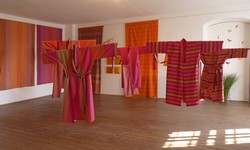Jitka Staňková
The title of the exhibition of Eva Jandíková refers to the project presenting textile art related to the thousand-year tradition of canvas processing. The textile art exhibition was held between June and September 2010 in the town of Rychnov nad Kněžnou (Czech Republic).
Canvas was, up to the beginning of the 20th century, a marginal element of the traditional processing of patterned linen in the Czech lands. It did not vanish due to the fact that many domestic weavers, to whom women delivered the yarn they had prepared for further processing on a hand-loom, used it. Two lines of Canvas patterns are possible – warp and weft – and, weave (linen, twilled weave, satin, etc.) can be used to change contrast and thickness of colour threads. This fabric using strips and squares was used both for decoration and for ceremonial purposes. The Czech canvases that were produced in large amounts in manufactories were so popular in the 19th century that they were exported to the foreign customers in Germany, Spain, Portugal, etc. The Czech canvas made by country people won recognition in the development of this art in Europe and worldwide.
Strips and squares remained popular patterns. Canvas was promoted from a craft to an art. Eva Jandíková got inspiration for combinations and mixing colours from nature. As a result, new rhythms, lines, gradations were produced. The author uses shades of colours rather than base colours. The fabric she produces is softer, finer and lighter than a typical canvas. The exhibition displayed the use of canvas in the clothes designed by contemporary visual artists.
